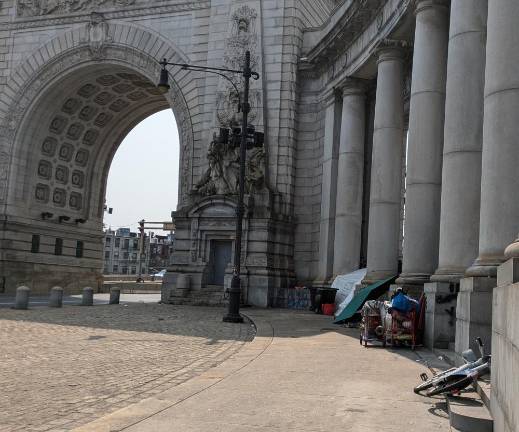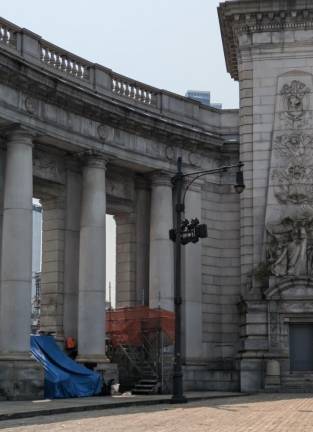Adams Addresses Manhattan Bridge Plaza Shantytown: “You Can’t Do It One and Done”
When asked by Straus News about the recent disappearance and then reemergence of a shantytown around the foot of the Manhattan Bridge a short distance from Chinatown, Mayor Adams said he was not aware of it, but promised to take a look that night.
It’s easier to build a shantytown than to take it down.
This—according to both Our Town Downtown observation and recent comments from Mayor Adams—among the lessons learned from recent events at the Manhattan Bridge Plaza, where a persistent colony of less-than-sanitary and often drug-addled homeless have taken up residence in recent years.
In some ways, the encampment is easy to overlook. If one doesn’t live in the immediate Chinatown neighborhood, drive over the bridge to Brooklyn or walk past its entrance at Bowery and Canal Street, a person might never see it at all. Others, seeing the tarpaulins and trash beyond the plaza’s large pigeon population might think it’s some kind of half-neglected construction site.
Ask the agency responsible for maintaining the bridge, the Department of Transportation, what’s going on and you’ll likely receive no answer. Despite Hizzoner’s best intentions, the City of Yes, it’s apparent, still has some bugs to work out.
Which doesn’t mean the Mayor—or the DOT—is disinterested in the problem.
To the contrary, in early August, the combined forces of the Department of Homeless Services, NYPD, the Department of Sanitation and the DOT removed the shantytown—tarps, tents, shopping carts, e-bikes, scooters and all manner of organic and inorganic waste were miraculously gone.
To say the city doesn’t care, or that it’s unable to address the problem, is simply wrong; Straus News has the pictures the prove it.
For a brief stretch of days, architecture fans could rejoice and revel in the imposing neo-classical Beaux Arts power and elegance of plaza designed by Carrère and Hastings. History buffs could again recall the ceremonies surrounding the bridge’s December 31, 1909, which played such a large part on the final day of the Mayoralty of George B. McLellan Jr.
This respite from squalor was brief, however. Within days, the shantytown was back.
Mayor Adams was asked about this at his weekly regular Tuesday press conference on August 13.
“You know, the success we’ve had, Deputy Mayor Williams-Isom has had around these shanty towns, these encampments, has been a combination of bringing together our social service agencies, Department of Sanitation, the Police Department, and her team.
“As we find a location, there’s a process,” he continued. “We don’t just go and close it down automatically. There are some rules that we must do. Post a sticker. Department of Sanitation must do the announcement. We try to get services in there. So there’s some clear rules that we carry out before we close down an encampment.”
Having said that, Adams acknowledged the difficulties in keeping a shantytown from returning.
“We’ve been successful because we go back and we revisit them, and we connected the New York City Police Department to do routine patrol. They have an obligation to identify them, but there’s a process to doing so. And one day we need to show all of these, we need to do a real display of the numbers that we’ve closed down and how it has changed drastically the quality of the life of the community.
But he acknowledged until Our Town Downtown posed the question, he was not aware of this particular shantytown. “We will look at under the Manhattan Bridge. I’m surprised I didn’t see it because normally I ride around 1, 2 a.m. at night and find encampments. So now you got me tempted. I’m going to be looking at that this [Aug 13] evening. But we’ve made a huge dent on these encampments. And you’ve got to go back. You can’t do it once and done. Some you have to go back over and over again. And so we’re going to take a look at that location as well.”
Godspeed, Hizzoner, godspeed.

